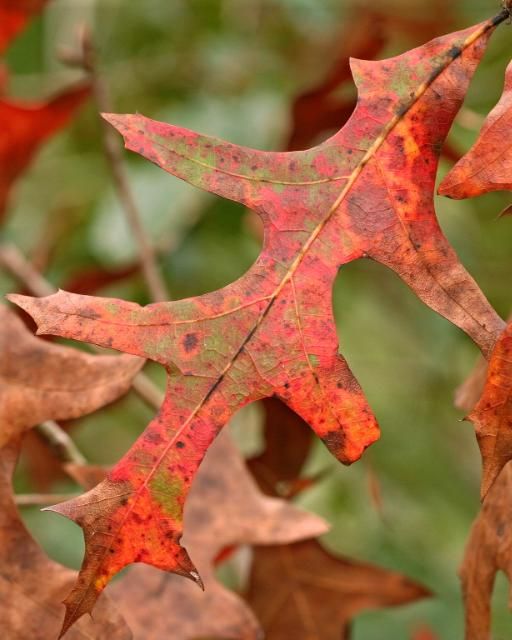Family
Fagaceae, beech and oak family.
Genus
Quercus comes from the Latin name for "oak" and is formed from two Celtic words: quer meaning "beautiful" and cuez meaning "tree."
Species
The genus name laevis stems from the Latin word for "smooth, slippery, or polished," and it refers to the nearly hairless leaves that remain after most pubescence has sloughed off by late season.
Common Names
Turkey Oak, Turkey-Foot Oak, Scrub Oak
The common names "turkey oak" or "turkey-foot oak" come from the shape of the leaves, which resemble a turkey's foot or foot print. The name "scrub oak" comes from the habitat in which this species is commonly found. However, at least six other oak species in Florida (Q. chapmanii, Q. geminata, Q. incana, Q. margarettae, Q. myrtifolia, and Q. pumila) may go by the same name, so it is best to use scientific names when referring to these tree species.
Description
This native deciduous oak frequents xeric sand dunes, sandhills, and ridges from Virginia south to central Florida and west to the southeastern portion of Louisiana. This tree generally grows to about 40 feet but can reach heights of 70 feet. Turkey oak will grow best in full sun and tends to remain in the shrub layer when shaded. Leaves are simple and alternate, grow from 4 to 8 inches long, and have 3 to 7 lobes with deep sinuses. The top side of the leaf is light green, and the bottom side is a paler or duller green with a characteristic reddish pubescence or hair in the vein axils when the leaves are young. Veins on the top and bottom surfaces of the leaf are prominent, and the margins or edges of the leaf are entire or smooth. Bark is gray to darker gray on the outside, deeply furrowed with irregular ridges, and the inner bark is a reddish color. Fruits are 3/4 to 1 inch elliptical or egg-shaped acorns with about 1/3 of the nut housed in a bowl-shaped cup. Acorns are generally produced every year and take two years to mature.

Credit: Mary Keim, CC BY-NC-SA 2.0
Allergen
All members of the Quercus genus are known to produce large amounts of pollen, making both deciduous and evergreen oaks highly to extremely allergenic.
Storm Tolerance
Turkey oak has a high resistance to wind.
Applications
Commercial/Practical
Generally, the quality of turkey oak wood is low, and it has little commercial value. However, when properly seasoned turkey oak is used for firewood and is a main source of such for many barbecue restaurants. Tannins from the bark and twigs have also been used to stain or tan leather.
Horticultural
Turkey oak is a useful specimen to have in the yard or landscape if providing food for wildlife is a goal. It is drought tolerant, making it ideal for homeowners interested in planting trees that require less water. In addition, turkey oak is an attractive tree due to its turkey-foot-shaped leaves that turn shades of yellow, orange, and red in the winter. However, because this oak does sprout from underground runners, it should not be planted where this growth habit will be an issue.
Wildlife
Acorns from the turkey oak provide an important food source for black bear, northern bobwhite quail, white-tailed deer, small mammals, and wild turkey.
References
Austin, D. F. 2004. Florida ethnobotany. Boca Raton, FL: CRC Press.
Borror, D. J. 1988. Dictionary of root words and combining forms (1st ed.). Mountain View, CA: Mayfield Publishing Company.
Duryea, M. and E. Kampf. 2007. Selecting Southeastern Coastal Plain tree species for wind resistance (FOR118). Gainesville, FL: UF-IFAS Florida Cooperative Extension Service. Retrieved from https://edis.ifas.ufl.edu/fr174
Floridata.com. 2003. Quercus laevis, Retrieved from http://www.floridata.com/ref/Q/quer_lae.cfm
Gledhill, D. 1989. The names of plants (2nd ed.). Cambridge: Press Syndicate of the University of Cambridge.
Godfrey, R. K. 1988. Trees, shrubs, and woody vines of Northern Florida and adjacent Georgia and Alabama. Athens, GA: The University of Georgia Press.
Harlow, R. F. 1990. Quercus laevis. In R. M. Burns, B. H. Honkala and Technical Coordinators (Eds.), Silvics of North America: Volume 2. hardwoods: USDA Forest Service, Agricultural Handbook 654.
Kurz, H. and R. K. Godfrey. 1993. Trees of Northern Florida. Gainesville, FL: University Press of Florida.
Little, E. L. 2005. National Audubon Society field guide to trees, Eastern region. New York, NY: Alfred A. Knopf, Inc.
Nelson, G. 1994. The trees of Florida: A reference and field guide. Sarasota, FL: Pineapple Press.
Ogren, T. L. 2000. Allergy-free gardening: The revolutionary guide to healthy landscaping. Berkeley, CA: Ten Speed Press.
Stein, J., D. Binion, and R. Acciavatti. 2003. Field guide to native oak species of Eastern North America. Morgantown, WV: USDA Forest Service.